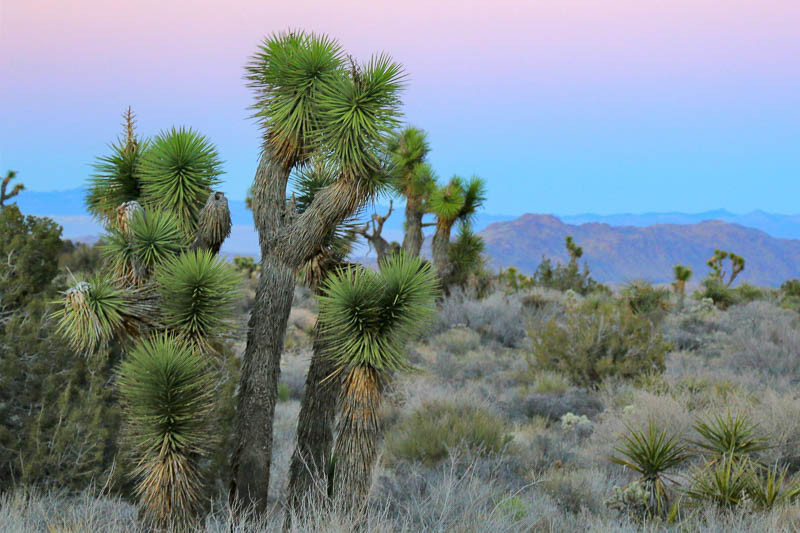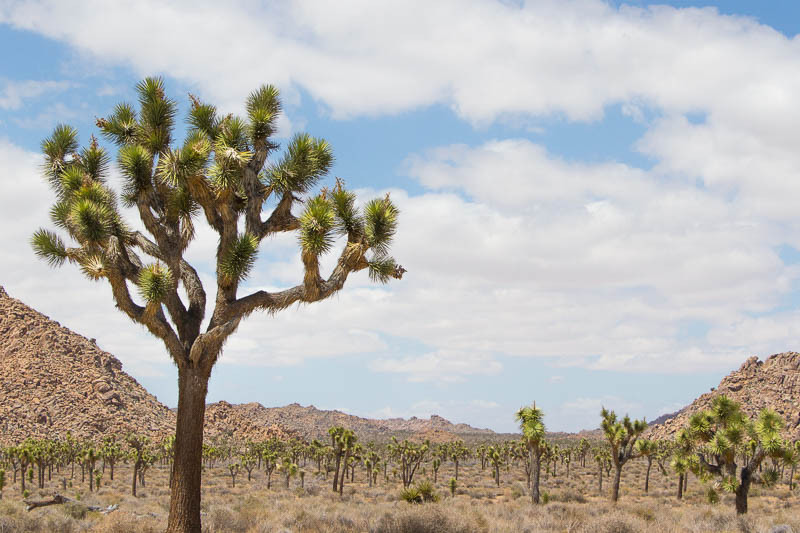Joshua Tree, Tree Yucca, Cactus Yucca, Yucca Palm
The Joshua Tree, scientifically known as Yucca brevifolia, is not only a plant of unique beauty but also an important component of its native desert ecosystem. Its resilience and distinctive appearance make it a fascinating subject for study and a cherished symbol of the American Southwest.
The Joshua Tree is an iconic plant of the Mojave Desert. It belongs to the Asparagaceae family, along with agaves or hostas. Known for its unique, twisted branches and spiky silhouette, it features a stout trunk with a dense crown of sharp, gray-green leaves. In spring, it blooms with clusters of creamy-white flowers, attracting various pollinators. This desert icon, living up to 150 years, creates a striking visual in arid landscapes, symbolizing resilience and beauty in harsh environments while providing habitat for diverse desert wildlife.
Native: This species is native to southwestern North America, particularly the Mojave Desert in southeastern California, Nevada, Arizona, and Utah. It thrives in open desert areas at elevations from 1,300 to 6,000 feet.
Plant Type and Habit: The Joshua Tree is a large, slow-growing, upright evergreen tree with a stout trunk, heavy branches, and an open, rounded crown of spiky leaves.
Size: This plant can grow 15 to 30 feet tall and wide (4.5 to 0 meters) at maturity, though growth is slow and spread largely depends on age.
Flowers: It produces magnificent terminal panicles, 20 inches long (50 cm), of creamy-white, bell-shaped flowers. These flowers are large and showy, often considered one of the plant’s most striking features. The bloom time is typically in the spring. However, flowering is not an annual event and can vary based on environmental conditions. After flowering, it produces brown, woody capsules, 1.5 to 3 inches long (4-7 cm), which contain many flat, black seeds.

Foliage: Rosettes of stiff, narrow, sharply pointed, gray-green leaves, 6-14 inches long (15-35 cm), are clustered near the branch tips. The old dead leaves hang on the plant, covering the trunk and stems.
Trunk: The trunk is fibrous and thick, covered in a rough bark. It can store significant water reserves, an adaptation to its desert habitat.
Uses: A signature species of the Mojave Desert, it is a great specimen plant for xeriscape gardens or desert gardens.
Hardiness: Yucca brevifolia is hardy in USDA zones 6 through 10. It is well-adapted to extreme temperature variations typical of its desert habitat.
Wildlife: Joshua Tree is an important source of food and shelter for wildlife. Around 25 species of birds use Joshua trees as nesting sites, and small mammals eat the seeds. The blooms attract the Yucca moth, the plant’s primary pollinator.
Toxicity: The roots contain saponins, which are mildly toxic to humans. However, saponins are toxic to cats, dogs, or horses. Wear gloves and other protective equipment when handling.
Deer and Rabbit: The Joshua Tree is generally resistant to deer and rabbits, due to its spiky foliage and tough texture,.
Drought: It is extremely drought-tolerant, able to survive long periods without water, making it an ideal plant for xeriscaping in arid environments.
Invasiveness: It is not considered invasive and grows relatively slowly, maintaining a stable presence in its native ecosystem.
Benefits: Its benefits include low maintenance, drought tolerance, and its role in desert ecology as a food source and habitat. Its unique shape and striking flowers also make it a valuable ornamental plant.

Light: Joshua Trees thrive in full sun. They need at least 6 hours of direct sunlight daily to grow well.
Soil: Prefer well-draining, sandy soils. They are adapted to poor, rocky soils and do not do well in wet, compacted soils.
Water: Drought-tolerant once established. Water sparingly, allowing the soil to dry out between waterings. Overwatering can lead to root rot.
Fertilizer: Generally, they do not require fertilizer. If necessary, use a balanced, slow-release fertilizer in early spring.
Pruning: Minimal pruning required. Remove old flowering stems, but leave the dried leaves. These absorb moisture and help sustain and insulate the plant, especially in cold, desert areas.
Propagation: Propagate by seed, rhizomes, stem cuttings, or by digging offsets.
Pests and Diseases: Relatively resistant to pests and diseases. Watch for root rot due to overwatering and occasionally mealybugs or scale insects.
| Hardiness |
6 - 10 |
|---|---|
| Climate Zones | 7, 9, 10, 11, 12, 13, 14, 15, 16, 18, 19, 20, 21, 22, 23 |
| Plant Type | Trees |
| Plant Family | Asparagaceae |
| Genus | Yucca |
| Common names | Yucca, Joshua Tree |
| Exposure | Full Sun |
| Season of Interest |
Spring (Early, Mid, Late) Summer (Early, Mid, Late) Fall Winter |
| Height |
15' - 30' (4.6m - 9.1m) |
| Spread |
15' - 30' (4.6m - 9.1m) |
| Maintenance | Low |
| Water Needs | Low |
| Soil Type | Loam, Sand |
| Soil pH | Acid, Alkaline, Neutral |
| Soil Drainage | Well-Drained |
| Characteristics | Showy, Evergreen |
| Native Plants | California, United States, Southwest, Arizona, Nevada, Utah, Rocky Mountains |
| Tolerance | Drought, Deer |
| Attracts | Birds, Butterflies |
| Garden Styles | Gravel and Rock Garden |
| Hardiness |
6 - 10 |
|---|---|
| Climate Zones | 7, 9, 10, 11, 12, 13, 14, 15, 16, 18, 19, 20, 21, 22, 23 |
| Plant Type | Trees |
| Plant Family | Asparagaceae |
| Genus | Yucca |
| Common names | Yucca, Joshua Tree |
| Exposure | Full Sun |
| Season of Interest |
Spring (Early, Mid, Late) Summer (Early, Mid, Late) Fall Winter |
| Height |
15' - 30' (4.6m - 9.1m) |
| Spread |
15' - 30' (4.6m - 9.1m) |
| Maintenance | Low |
| Water Needs | Low |
| Soil Type | Loam, Sand |
| Soil pH | Acid, Alkaline, Neutral |
| Soil Drainage | Well-Drained |
| Characteristics | Showy, Evergreen |
| Native Plants | California, United States, Southwest, Arizona, Nevada, Utah, Rocky Mountains |
| Tolerance | Drought, Deer |
| Attracts | Birds, Butterflies |
| Garden Styles | Gravel and Rock Garden |
How many Yucca brevifolia (Joshua Tree) do I need for my garden?
| Plant | Quantity | |
|---|---|---|
| Yucca brevifolia (Joshua Tree) | N/A | Buy Plants |
Create a membership account to save your garden designs and to view them on any device.
Becoming a contributing member of Gardenia is easy and can be done in just a few minutes. If you provide us with your name, email address and the payment of a modest $25 annual membership fee, you will become a full member, enabling you to design and save up to 25 of your garden design ideas.
Join now and start creating your dream garden!
Create a membership account to save your garden designs and to view them on any device.
Becoming a contributing member of Gardenia is easy and can be done in just a few minutes. If you provide us with your name, email address and the payment of a modest $25 annual membership fee, you will become a full member, enabling you to design and save up to 25 of your garden design ideas.
Join now and start creating your dream garden!